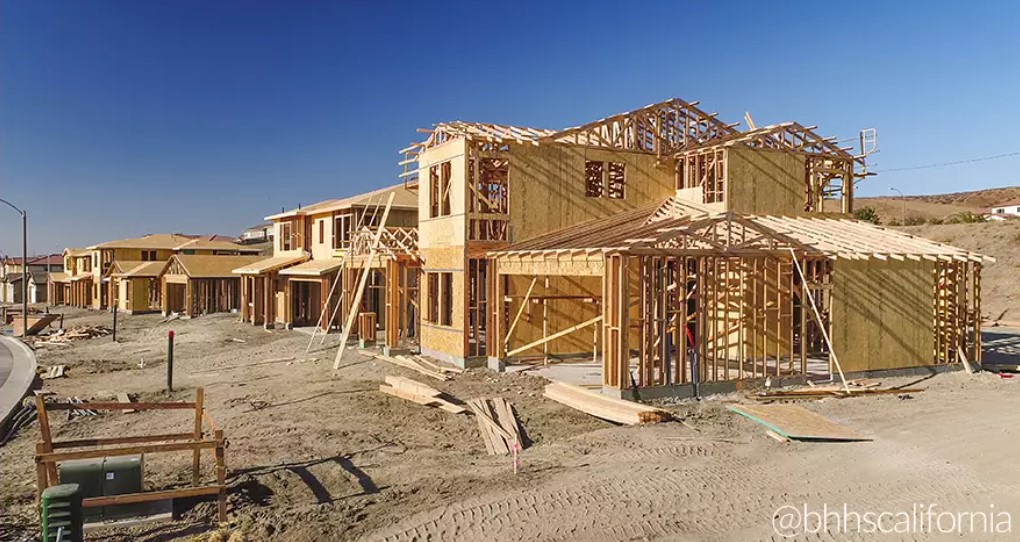
Author: BHHSCalifornia
Is it better to buy or build a house? Whatever you decided, the process of buying or building the home of your dreams comes with its own decisions and limitations. You have to consider the home’s design and features of the home, along with the surrounding location and amenities.
Depending on your budget and the extent of your dreams, it may be feasible to purchase a plot of land to build a new home on. That isn’t a cheap endeavor, but given the location and the extent of the floor plans that you want, it’s not impossible. Learn more about the price of land in California.
Understanding building costs
The exact costs of building a home will vary based on dozens of factors, like the location and the size of the house you want to build. Costs can vary widely just from neighborhood to neighborhood.
California is historically one of the most expensive states to live in. Building a house will cost about $200 per square foot on average, though a custom or luxury home can cost more than $500 to build. In California, building a home may cost upwards of $600,000 on average.
However, it’s important to note that those costs constantly fluctuate especially with growing supply chain issues and general material deficits globally. It is also important to understand that those costs strictly cover construction. They do not include breaking and clearing the ground, obtaining permits and licenses, and purchasing the actual plots of land. That latter is obviously important, considering you need land to build a home on.
Before purchasing the land, it might be necessary to hire a surveyor for a land survey, especially when you’re interested in a piece of vacant land. The land survey has several uses, including:
Determines the boundary line of the raw land (it also shows the property line if there is a property right next to it)
Reveals the geographical features
Assesses the buildability of the land
All in all, the land survey is one way to determine if the land is worth buying or not.
Plots and acreage in California
Land is priced per acre. An acre measures 43,560 square feet, and a square mile contains about 640 acres. How much is an acre of land worth in California? On average, you can expect to pay about $5,000 to $12,000 per acre. However, there are many exceptions to the rule, and location is a big part of that. Highly desirable areas with beachside views or other amenities could go for well above the average price. In 2018, a 1.43-acre lot in Atherton sold for about $6.9 million.
Keep in mind that one acre is a lot of land. Unless you plan to install a full mansion, it’s rare to even pay for a full acre of land. The national average for a home lot is about 10,800 square feet. In California, the average size of a home lot is about 5,500 square feet, nearly half the size of the national average.
The average cost of land in California
As mentioned, location is one of the most significant factors that determine how much you will pay for a plot of land. An acre in one state may be considerably more than an acre in another state, even if they are the exact same size of land. California is historically more expensive than other states, a result that is a combination of good weather all year round, the density of the major cities, and numerous other market forces.
However, even within the state of California, land costs can vary from region to region, city to city, and even neighborhood to neighborhood. For example, Los Angeles County has a median price of $1.38 per square foot (over $60,000 per acre).
What to know when you buy land in California
Buying a plot of land and building a home on it is a severe endeavor, especially in California. Here are some things to keep in mind as you go through the process.
Determine your budget
Before you even start looking at listings, understand that this isn’t a short-term project. Buying land and building on it can take a long time and a lot of money. Start by figuring out your own budget for the whole process, not just buying the plot of land. Take into account the cost of permits and licenses, the actual construction of your home, and any adjustments that you might need to make in the land to make your home habitable. If the area does not have plumbing or access or running water, electricity, and other utilities, you need to plan for costs to install those home systems.
Finding land
There are nearly endless platforms for finding the perfect plot of land. Landowners will sell their land through newspaper classified ads, specialty magazines, and online sites. You can also sometimes purchase land directly from the government. Local jurisdictions sometimes have excess land to sell, or they may have repossessed land that they are then selling.
Choosing the right plot
Even if you’ve found the right bit of dirt, you have to make sure that it is actually zoned for housing. Zoning laws are designed to restrict the size of buildings and the types of buildings that can be built on that land. It’s why you won’t see large metallurgy factories built directly in the middle of a residential community.
You also want to check the physical land itself. Make sure the soil won’t hinder or impede your ability to actually build new home builds on top of it. Consider if you’ll have trouble installing electricity, if the elevation may be an obstacle, or if there are any larger environmental issues to consider. That generally requires a lot of research and a lot of communication with more informed people. Expect to talk with architects, general contractors, utility companies, city agencies, and neighborhood councils.
Sloping California
In Los Angeles and other parts of California, finding a flat piece of land can be surprisingly difficult. While you might find plenty of plots to choose from, many are on slopes, some of which are steeper than others. Developing on slopes isn’t impossible, but it does pose extra problems and considerations, which often means spending more money. You have to factor in concrete pillars, retaining walls, and other supports that keep the home from sliding right down that hill.
Paying for the land
Most experts recommend paying for plots of land with cash. That’s because getting a land mortgage can be difficult, more so than getting a mortgage for a house. Land loans tend to carry a lot of risks as they don’t have generally come with any collateral. That means high down payments, sometimes as much as 50 percent of the total cost, and high-interest rates.
Completing your purchase
To officially close on a land purchase, you need to sign a land purchase agreement, which specifies the amount of money you are paying for the land along with the amount that you are putting down. The agreement is essentially a contract between you and the seller that essentially ensures that you get the land and the seller gets their money. You will also have to review state-specific real estate forms, a closing statement that reviews all the costs, and the deed that transfers the land title from the former owner to you.
Be patient
Even after making a land purchase, don’t expect to break ground or start laying concrete immediately. Depending on the situation, the process of reviewing and permitting your home’s design and floor plans can take a long time. You could look at a whole year or two before you can even begin construction. It might be worth hiring an expediter (a business to guide you through the process) along with an architect and contractor.
Look for “shovel-ready” plots
If you want to try to speed up the process a bit, look for lots that are advertised as “permit ready” or “shovel ready.” These lots typically have the design and floor plans for the house included, doing away with all the permitting and long waits mentioned above. Granted, these shovel-ready plots will cost you extra. Expect to pay as much as $100,000 on top of the regular cost of land. That can add up a lot, but it might be worth it if you are on a specific timeline or if you don’t want to hang in bureaucratic limbo.
Competing with developers
Finding a home already comes with plenty of competition, but if you want to buy a plot, you may have to compete with developers. Most buyers these days are developers who have the time, resources, and connections to the right people. That can be really intimidating as a person just looking for their dream home, but working with the right people and assembling a team of architects and contractors can be a big help.
Purchasing a plot of land is no small feat, and you can generally expect to pay a lot for land in California before you ever even start thinking about construction. If you need help finding the right plot (or maybe even other concerns, like tips for building a spec home), consider working with us. We can work with you to find the perfect piece of land for the home of your dreams while keeping your budget and personal needs in mind.

